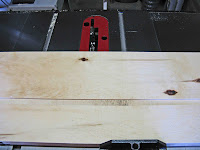 |
| A Variety of Drill Bits |
It has been two weeks since my last entry, a break which I attribute both to the Thanksgiving holiday and to the time I spent repairing my ancient Toyota. The cold weather here in Wisconsin has also made it very challenging to work in the unheated portion of my workshop, so I have no new woodworking projects to describe. In the meantime, I felt a discussion of the different types of woodworking drill bits might prove of some interest.
The tools in the photo above are, from left to right, a Forstner bit, a brad point bit, a twist drill, an adjustable bit for use in a hand brace, an auger bit also for use with a brace, and a spade bit. All the bits except the auger bits can be used with either a hand drill or an electric drill, the augers being designed for hand use only.
 |
| Hand Drills |
The tool below the hand brace is commonly known as an eggbeater drill, so named for its resemblance to another bit of obsolete technology, the egg beater. This device is designed for use with twist drill bits and is suitable for use in either wood or metal. No batteries are required. In the past, such hand drills were manufactured in a range of sizes, some with two-speed gearing. The largest of these were called breast drills and featured a metal plate shaped to fit the operator's chest, allowing extra pressure to be applied while drilling.
I will go into greater detail regarding the different types of drill bits in future entries, but for now I would like to point out that the most common bit, the twist drill, was designed for use in metal not wood. While a sharp twist drill has its uses in woodworking, it requires a pilot hole for accuracy and is prone to splintering the work. What all the woodworking bits have in common are a sharp central point to accurately locate the hole and some form of spurs to score the circumference of the hole and prevent splintering. Auger bits in particular have a lineage going back centuries and are among the most efficient hand tools ever invented.
More to come...















































